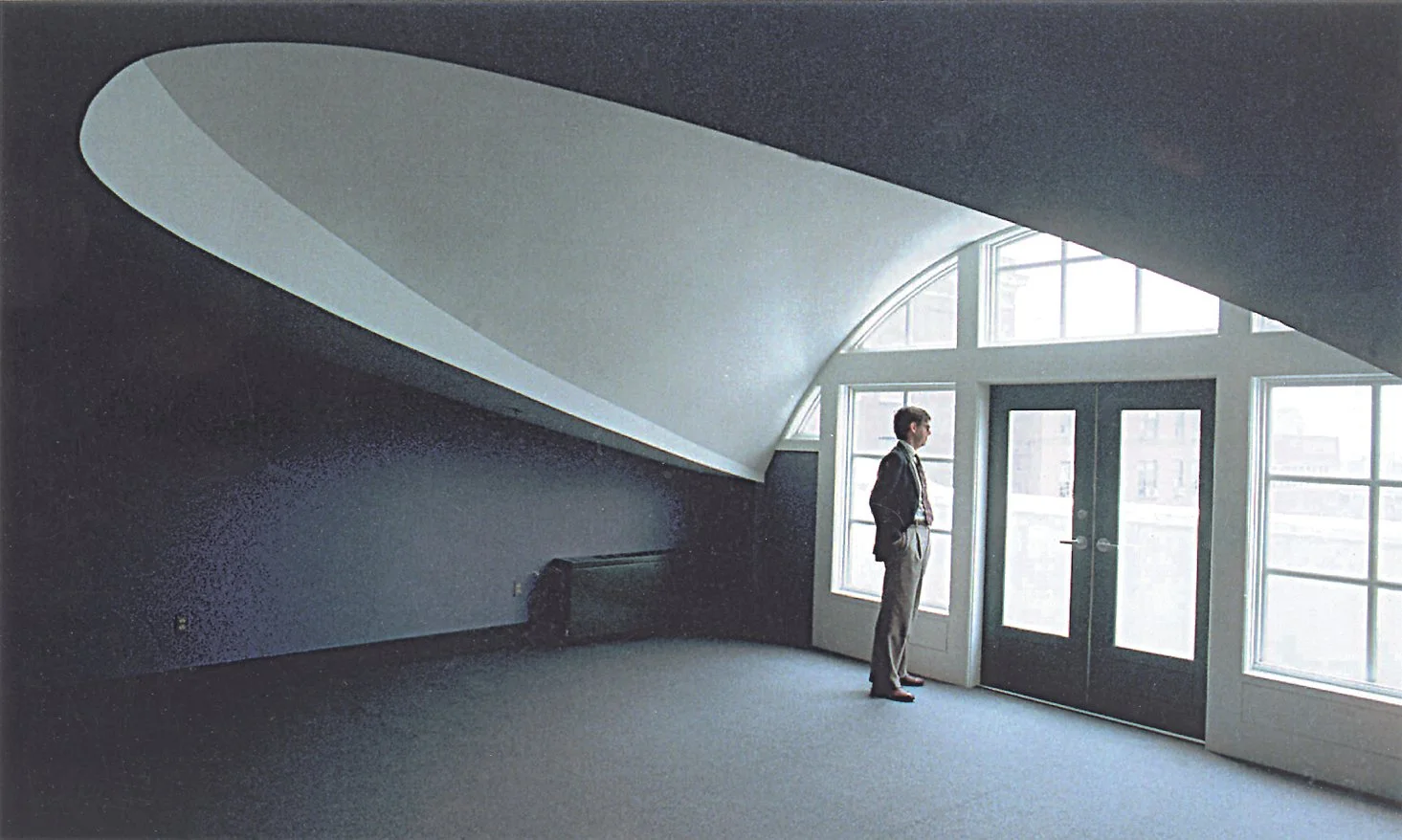Open collaborative spaces are the new norm at Metso Outotec’s York County office after a major upgrade by the Murphy & Dittenhafer Interiors Studio.


When Metso Outotec sought out the help of Murphy & Dittenhafer Interiors to upgrade its building in York County, Pennsylvania, the goal was to accentuate how people work.
Prior to M&D coming into the space, each of the building’s three floors was made up of dozens of individual offices. There was very little shared community-use space.
Metso Outotec is based out of Finland, where private offices are not the norm, says Lisa Clemens, Associate Principal and Lead Interior Designer at Murphy & Dittenhafer Interiors. Instead, M&D got rid of every single private office and designed each floor to have a “Huddle Core” with open office spaces around it.
“A lot of traditional concepts are going away because people are changing the way they work,” Clemens says. “It’s more collaborative and more remote.”
The design included various-sized meeting spaces throughout the building so when employees need to have a meeting or make a private phone call, there are places to go besides at an open-concept desk.
The Metso project was the first time Clemens designed a space with every desk having a sit and stand option. The entire desktop goes up for anyone wanting to stand while working.
Listening to their clients
With so many major changes to the workplace environment, Clemens knows the importance of communicating with her clients.
“The challenge with an open office concept is you’ve got to find a way to communicate that change with your users in a way that they’re going to get excited about it,” she says. “People say, ‘I need my tchotchkes, I need to hang stuff on my door.’ We’ve all experienced opportunities to work differently in the last two years. The whole concept was moving that direction already — COVID-19 just helped push it along.”
Like us on Facebook!
Clemens sat down with each department to talk about storage and space needs and to learn what was most important to people. Balancing employee wants with company requests was a top priority.
“A lot of time you say interior design — and people think you mean paint colors,” Clemens says.
The process involves so much more, such as processing how people move and work in a space.
Through talking with the employees, she learned that Metso has two different sets of engineers. The first group works on repairing and upgrading older equipment. The second group builds new equipment and is constantly coming from and going to the lab, which is at a different location in York. This group hardly ever sits down.
Clemens designed a floor for each group of engineers, each encompassing around 150 employees.
The second floor became a more collaborative space, with additional central “Huddle Core” seating where engineers can intentionally overhear each other’s conversations.
The third floor, more geared toward the repair engineers, has more traditional cubicle spaces and more storage.
One of the greatest benefits of the open concept spaces has been opening every workspace to more natural daylight. It’s something that M&D often tries to do in its designs.
“People are just happier,” Clemens says.
Creating useful elements
Clemens typically tries to include the use of curves in every design. She also aims to turn corridors and circulation spaces into useful areas.
In the Metso project, there was a wide corridor near the elevator on each floor. Clemens designed a curved wall on one side and tucked four small focus rooms behind it for one to two people. The spaces are intended to be used by those needing a break, private phone call, or meeting.
Overall, the experience of designing the Metso space was a positive one for Clemens.
“The people are always my favorite part,” she says. “I also love doing space planning. It’s like putting a puzzle together. I care about space so much more than colors.”
Murphy & Dittenhafer Architects is working hard and collaborating with the community on an urban planning study for South George Street in York City.
“Historic preservation has always been a hallmark of ours for our 40-year history,” says M&D President Frank Dittenhafer II. These 10 projects exemplify our passion for this work.
It’s the 40th year of Murphy & Dittenhafer Architects, so Frank Dittenhafer II, President, is taking the time to highlight some of our most influential projects over the decades.
We’re celebrating 40 years of influence in Pennsylvania and Maryland. With that, we couldn’t help but reflect on some of the most impactful projects from our history.
Harford Community College’s expanded new construction Chesapeake Welcome Center is a lesson in Architectural identity
At Murphy & Dittenhafer Architects, we feel lucky to have such awesome employees who create meaningful and impressive work. Meet the four team members we welcomed in 2024.
The ribbon-cutting ceremony at the new Department of Legislative Services (DLS) office building in Annapolis honored a truly iconic point in time for the state of Maryland.
As Murphy & Dittenhafer architects approaches 25 years in our building, we can’t help but look at how far the space has come.
Murphy & Dittenhafer Architects took on the Architecture, Interior Design, & Overall Project Management for the new Bedford Elementary School, and the outcome is impactful.
The memorial’s groundbreaking took place in June, and the dedication is set to take place on November 11, 2024, or Veterans Day.
President of Murphy & Dittenhafer Architects, Frank Dittenhafer II, spoke about the company’s contribution to York-area revitalization at the Pennsylvania Downtown Center’s Premier Revitalization Conference in June 2024. Here are the highlights.
The Pullo Center welcomed a range of student musicians in its 1,016-seat theater with full production capabilities.
“Interior designs being integral from the beginning of a project capitalize on things that make it special in the long run.”
Digital animations help Murphy & Dittenhafer Architects and clients see designs in a new light.
Frank Dittenhafer and his firm work alongside the nonprofit to fulfill the local landscape from various perspectives.
From Farquhar Park to south of the Codorus Creek, Murphy & Dittenhafer Architects help revamp York’s Penn Street.
Designs for LaVale Library, Intergenerational Center, and Beth Tfiloh Sanctuary show the value of third places.
The Annapolis Department of Legislative Services Building is under construction, reflecting the state capital’s Georgian aesthetic with modern amenities.
For the past two years, the co-founder and president of Murphy & Dittenhafer Architects has led the university’s College of Arts and Architecture Alumni Society.
The firm recently worked with St. Vincent de Paul of Baltimore to renovate an old elementary school for a Head Start pre-k program.
The market house, an 1888 Romanesque Revival brick structure designed by local Architect John A. Dempwolf, long has stood out as one of York’s premier examples of Architecture. Architect Frank Dittenhafer is passing the legacy of serving on its board to Architectural Designer Harper Brockway.
At Murphy & Dittenhafer Architects, there is a deep-rooted belief in the power of combining history and adaptive reuse with creativity.
University of Maryland Global Campus explores modernizing its administration building, which serves staffers and students enrolled in virtual classes.
The Wilkens and Essex precincts of Baltimore County are receiving solutions-based ideas for renovating or reconstructing their police stations.
The firm has earned the designation annually since 2016 in recognition of its commitment to supporting newer professionals in the field.










































To round out our 40th-year celebrations, enjoy 10 more impactful and diverse Architecture projects designed by M&D. These projects, most of which have received design awards, confirm the variety in design (from scale to usage) that we continue to be involved in today.